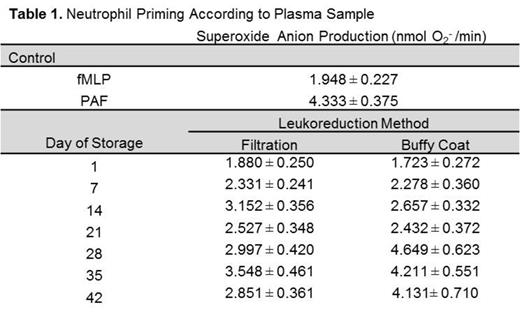Abstract
Background:
Pre-storage leukoreduction (LR) of whole blood (WB) or red blood cells (RBC) reduces white blood cell (WBC) and platelet contamination and decreases the amount of biologic response modifiers (BRMs) implicated in the development of transfusion-related acute lung injury (TRALI). There are two primary methods of LR used world-wide, however there has not yet been a side-by-side comparison of the buffy coat method to the in-line filtration, in terms of the ability to minimize the neutrophil (PMN) priming activity in the supernatant. We hypothesize that LR by buffy coat is equal to LR by filtration in minimizing PMN priming activity.
Method:
Five units of WB were drawn from healthy volunteer donors. Plasma was removed by centrifugation and the RBC units were equally divided by weight; 50% were LR by buffy coat removal and 50% were LR by in-line filtration (Haemonetics RC2D) into bags containing AS-3 additive solution (110 ml) and stored at 2-6oC per AABB criteria. Sterile couplers were used to obtain samples weekly during storage. The supernantant was isolated by centrifugation (5,000g for 7 min, followed by 12,000g for 6 min) and stored at -80oC. PMNs were isolated from heparinized WB from healthy volunteer donors by standard techniques. PMNs were incubated with plasma samples for 5 min at 37oC then activated with 1uM formyl-MLF (fMLF) and the maximal rate of O2- was measured. Priming activity is the augmentation of the maximal rate of superoxide production in response to fMLF. Supernatants were immunoblotted for peroxiredoxin-6, an intracellular RBC enzyme.
Results:
LR by filtration decreased WBC amount by >3 logs and platelets by >2 logs whereas LR by buffy coat reduced both WBC and platelets by only a single log. The supernatants from both buffy coat and filtration LR showed no difference in PMN priming vs. albumin or buffer-treated controls on day (D) 1 and demonstrated an increase in O2- production on D1 vs. D42 of storage (Table 1). However, the supernatants from buffy coat LR RBCs demonstrated significantly greater PMN priming activity as compared to supernatants from filter LR RBCs (2.4-fold). Samples from D14 and D28 also showed a statistically significant greater increase in O2- production in buffy coat LR samples compared to filtered samples. Additionally, there was increased immunoreactivity for peroxiredoxin-6 in buffy coat supernatants vs. filtered RBC supernatants on identical days of storage (Fig.1).
Discussion:
Filter LR is more effective in reducing WBC and platelet contamination, and significantly decreases the accumulation of PMN priming activity and peroxiredoxin-6 immunoreactivity in the RBC supernatant. LR via filtration appears to produce RBC units with less cellular contamination, decreased BRMs and less release of intracellular enzymes. Further testing is required to determine if these LR RBC units are clinically safer than RBCs which undergo buffy coat LR.
No relevant conflicts of interest to declare.
Author notes
Asterisk with author names denotes non-ASH members.



This feature is available to Subscribers Only
Sign In or Create an Account Close Modal